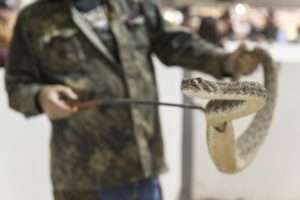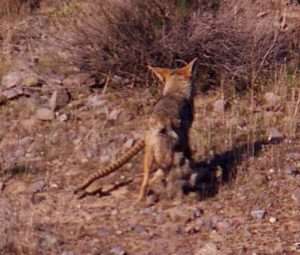 Recently I read that the last rattlesnake roundup in Georgia is being renewed as a wildlife-friendly festival. Looking at the Whigham Rattlesnake Roundup event website, the photos from previous festivals show that there was a lot of fun to be had outside of catching and killing rattlesnakes, and this year’s reptile show had a bunch of talks that make me really wish I was closer! Plus it sounds like attendees got to see some impressive rattlers and other cool reptiles, alive and well. I wish everyone there the very best, and I hope their improved event brought them increased success and will continue to do so well into the future.
Recently I read that the last rattlesnake roundup in Georgia is being renewed as a wildlife-friendly festival. Looking at the Whigham Rattlesnake Roundup event website, the photos from previous festivals show that there was a lot of fun to be had outside of catching and killing rattlesnakes, and this year’s reptile show had a bunch of talks that make me really wish I was closer! Plus it sounds like attendees got to see some impressive rattlers and other cool reptiles, alive and well. I wish everyone there the very best, and I hope their improved event brought them increased success and will continue to do so well into the future.
This news was a bright spot in my day, and it’s a sign of a trend toward the better. This is just the latest event that has left behind a legacy of cruelty and chosen to focus instead on rattlesnakes as fascinating creatures that have long inspired and awed humanity.
What is a Rattlesnake Roundup?
Rattlesnake roundups started in the early 1900s as a way to reduce numbers of rattlers and other snakes, and over time they became celebrations complete with all the trappings of your average country fair. The snakes themselves were, of course, rounded up, and today each of these events can account for the removal of thousands of snakes from their natural habitat. Most never make it back home, and are slaughtered after being handled in stressful conditions in the last hours of their lives. They may be kicked, mutilated, force-fed alcohol, harassed into striking targets, and stuffed into small containers in such large quantities that many are crushed to death. Some roundups, like the well-known event in Sweetwater, TX, give people money for the snakes they bring in, providing even more economic incentive to capture and kill as many snakes as possible.
 Apart from the absolutely horrific and cruel treatment of living animals, anyone with even a basic understanding of how ecosystems work should be concerned by this point in this article. Whenever you remove large numbers of a native predator species from an area, the ecosystem suffers. Rattlesnakes are important predators of rodents and other small animals in their habitats, and they themselves may be food for other snakes, hawks and other birds, coyotes, bobcats, and other predatory wildlife, as well as various scavengers. The removal of rattlesnakes both contributes to rodent overpopulation, and may mean less food is available to other animals.
Apart from the absolutely horrific and cruel treatment of living animals, anyone with even a basic understanding of how ecosystems work should be concerned by this point in this article. Whenever you remove large numbers of a native predator species from an area, the ecosystem suffers. Rattlesnakes are important predators of rodents and other small animals in their habitats, and they themselves may be food for other snakes, hawks and other birds, coyotes, bobcats, and other predatory wildlife, as well as various scavengers. The removal of rattlesnakes both contributes to rodent overpopulation, and may mean less food is available to other animals.
The myth that humans need to be the ones to “keep the snakes in check” is based in a fundamental misunderstanding of how well the balance of nature fared for a very long time without our mass slaughters. Considering we still actively hunt coyotes, bobcats, and other mammalian predators, and thousands of hawks and other raptors die of lead poisoning every year (to say nothing of “shoot, shovel, and shut up“), we’re removing many of the animals that evolved over millions of years to help keep rattlesnakes in check.
Moreover, gasoline is very commonly used to drive rattlesnakes from their dens; this pollution not only persists in the environment, but it can kill, injure, or otherwise negatively effect many other species of animal, plant, and fungus, not just immediately but well into the future. This is especially true in fragile arid ecosystems where there is less rain to dilute or wash away the gasoline. And even when it is washed away, it ends up in local waterways where it can continue to pollute streams and rivers as it continues to spread through the watershed.
Finally, I want to add that these roundups are NOT the same thing as mass hunts of invasive animals like lionfish or Burmese pythons; while I personally feel that killing animals should never be taken lightly, removing invasive species is necessary in order to try to preserve the ecological balance. The Burmese pythons that have been decimating Florida’s native wildlife are not in the same category as native rattlesnakes that evolved in an ecosystem with checks and balances throughout their interrelationships with other species.
In short, traditional rattlesnake roundups are anything but sustainable or nature-friendly.
A Better Way
 The move toward educational rattlesnake events isn’t new. All the former roundups in Pennsylvania and Florida are now tailored toward natural history while maintaining their celebratory atmosphere, and with Whigham’s evolution Georgia can now be added to the roundup-free list. Unfortunately, thirteen roundups are still listed as actively hunting and killing rattlesnakes, so there remains some work to be done.
The move toward educational rattlesnake events isn’t new. All the former roundups in Pennsylvania and Florida are now tailored toward natural history while maintaining their celebratory atmosphere, and with Whigham’s evolution Georgia can now be added to the roundup-free list. Unfortunately, thirteen roundups are still listed as actively hunting and killing rattlesnakes, so there remains some work to be done.
But public opinion is changing, and with it comes pressure to get rid of old, outdated, and harmful ways of doing things. We don’t just see this with rattlesnake roundups, but outdoor-based economics in general. Traditionally communities have made money through extractive activities such as logging and mining. Even many tourist attractions like charter fishing, shellfish collecting, and foraging, are extractive by their very nature, taking animals, plants, and other natural materials from local habitats. Ecotourism, which has been on the rise in the past few decades, instead focuses on non-extractive activities like wildlife viewing and photography while boosting local economies in sustainable ways. The new and improved rattlesnake fairs that emphasize education are a great example of how communities can use the momentum of well-established events and also evolve them into something that can benefit from the growing demand for ecotourism.
Is it always going to be a smooth transition? Of course not. If an event had very little to offer besides “Let’s go kill some snakes!”, it’s going to have to find a different audience going forward. There may be a lot of resistance, especially from those who benefit economically from rattlesnake roundups who may be concerned their cash cow is about to disappear. And–let’s face it–there are those who will likely be perpetually convinced that “varmints” have no value other than as target practice.
Some may argue that we have bigger problems than a few thousand dead rattlesnakes. Sure, of course we do. Habitat loss is the single biggest cause of species endangerment and extinction, and is locked in a nasty feedback loop with climate change. But as I mentioned in last week’s article, we have lost 75% of all individual wild animals in the past fifty years. Every animal lost is a piece of that species’ genetic diversity gone, one less potential mate for another, fewer young being added to the population in the future, and the species becomes that much less likely to survive the other pressures we put on them as we destroy their homes. Would some have died naturally? Of course. But their natural reproduction rate was able to keep the species going before we began killing them en masse. As with many of our actions, it’s the rate at which we force change which is the problem. Even generally common species can become scarce locally when overhunted, which can throw the entire local ecosystem off balance.
 And it is an incredibly easy thing to choose to just–not kill rattlesnakes. Much simpler than solving climate change, much less time-consuming than restoring habitats. By allowing wildlife to simply live their lives we’re making an incredible positive impact. We can increase that impact by actively celebrating these amazing creatures, dispelling myths about them, and spotlighting what makes their very existence valuable in the first place.
And it is an incredibly easy thing to choose to just–not kill rattlesnakes. Much simpler than solving climate change, much less time-consuming than restoring habitats. By allowing wildlife to simply live their lives we’re making an incredible positive impact. We can increase that impact by actively celebrating these amazing creatures, dispelling myths about them, and spotlighting what makes their very existence valuable in the first place.
And that, to me, is a much better way.
